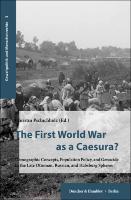The First World War as a Caesura?
Demographic Concepts, Population Policy, and Genocide in the Late Ottoman, Russian, and Habsburg Spheres.
Contributor(s)
Pschichholz, Christin (editor)
Collection
Knowledge Unlatched (KU)Language
EnglishAbstract
During the phases of mobile warfare, the ethnically and religiously very heterogeneous population in the border regions of the multi-ethnic empires suffered in particular. Even if the real military situation in the course of the war hardly gave cause for concern, the image of disloyal ethnic and national minorities was widespread. This was particularly the case when ethnic groups lived on both sides of the border and social and political tensions had already established themselves along ethnic or religious lines of conflict before the war. Displacements, deportations and mass violence were the result. The genocide of the Armenian population is the most extreme example of this development. This anthology examines the border regions of the Ottoman, Russian and Habsburg empires during the First World War with regard to radical population policy and genocidal violence from a comparative perspective in order to draw a more precise picture of escalating and deescalating factors.
Keywords
History; Military; World War I; Political Science; Genocide & War CrimesDOI
10.3790/978-3-428-58146-7ISBN
9783428181469, 9783428581467Publisher
Duncker & HumblotPublisher website
https://www.duncker-humblot.de/Publication date and place
2020Grantor
Imprint
Duncker & HumblotClassification
First World War
c 1914 to c 1918 (World War One period)
War crimes


 Download
Download